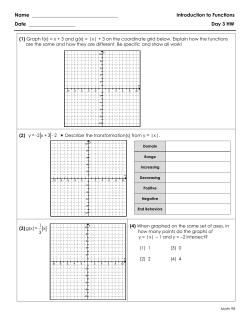
Section 2.6 – Families of Functions
Section 2.6 – Families of Functions Different nonvertical lines have different slopes, or y-intercepts or both. They are graphs of different linear functions. For two such lines, you can think of one as a transformation of the other. Section 2.6 – Families of Functions Essential Understanding There are sets of functions, called families, in which each function is a transformation of a special function called the parent. The linear functions form a family of functions. Each linear function is a transformation of the function y = x. The function y = x is the parent linear function. Section 2.6 – Families of Functions A parent function is the simplest form in a set of functions that form a family. Each function in the family is a transformation of the parent function. One type of transformation is a translation. A translation shifts the graph of the parent function horizontally, vertically, or both without changing shape or orientation. For a positive constant k and a parent function, f(x), f(x) +/- k is a verical translation. For a positive constant h, f(x +/-h) is a horizontal translation. Section 2.6 – Families of Functions Section 2.6 – Families of Functions Problem 1: How are the functions y = x and y = x – 2 related? How are their graphs related? Section 2.6 – Families of Functions Problem 2: How are the functions y = 2x and y = 2x – 3 related? How are their graphs related? Section 2.6 – Families of Functions Problem 2: What is the graph of y = x2 – 1 translated up 5 units? Section 2.6 – Families of Functions Problem 2: What is the graph of y = 3x translated up 2 units? Section 2.6 – Families of Functions Problem 2: The graph shows the projected altitude f(x) of an airplane scheduled to depart an airport at noon. If the plane leaves two hours late, what function represents this transformation? Section 2.6 – Families of Functions Problem 2: Suppose the flight leaves 30 minutes early. What function represents this transformation? Section 2.6 – Families of Functions Problem 2: Suppose the flight leaves 30 minutes early. What function represents this transformation? Section 2.6 – Families of Functions Problem 2: The graph shows the distance f(x) you will hike if you leave at 8 am. If you leave at 10 am, what function represents the transformation? Section 2.6 – Families of Functions A reflection flips the graph of a function across a line, such as the x- or y-axis. Each point on the graph of the reflected function is the same distance from the line of reflection as its corresponding point on the graph of the original function. Section 2.6 – Families of Functions Section 2.6 – Families of Functions When you reflect a graph in the y-axis, the xvalues change signs and the y-values stay the same. When you reflect a graph in the x-axis, the xvalues stay the same and the y-values change signs. For the function f(x), the reflection in the y-axis is f(-x) and the reflection in the x-axis is –f(x). Section 2.6 – Families of Functions Problem 3: Let g(x) be the reflection of f(x) = 3x + 3 in the y-axis. What is the function rule for g(x)? Section 2.6 – Families of Functions Problem 3: Let h(x) be the reflection of f(x) = 3x + 3 in the x-axis. What is the function rule for h(x)? Section 2.6 – Families of Functions Problem 3: Let g(x) be the reflection of f(x) = 2x – 7 in the xaxis. What is the function rule for g(x)? Let h(x) be the reflection of f(x) = 2x – 7 in the y-axis. What is the function rule for h(x)? Section 2.6 – Families of Functions A vertical stretch multiplies all y-values of a function by the same factor greater than 1. A vertical compression reduces all y-values of a function by the same factor between 0 and 1. For a function f(x) and a constant a, y = af(x) is a vertical stretch when a > 1 and a vertical compression when 0 < a < 1. Section 2.6 – Families of Functions Section 2.6 – Families of Functions Problem 4: The table a the right represents the function f(x). What are the corresponding values of g(x) and the possible graphs for the transformation g(x) = 3f(x). Section 2.6 – Families of Functions Problem 4: The table a the right represents the function f(x). What are the corresponding values of g(x) and the possible graphs for the transformation g(x) = (1/3)f(x). Section 2.6 – Families of Functions Section 2.6 – Families of Functions Problem 5: The graph of g(x) is the graph of f(x) = 4x compressed vertically by the factor ½ and then reflected in the y-axis. What is a function rule for g(x)? Section 2.6 – Families of Functions Problem 5: What transformations change the graph of f(x) to graph of g(x)? f(x) = 2x2 g(x) = 6x2 – 1 Section 2.6 – Families of Functions Problem 5: a. The graph of g(x) is the graph of f(x) = x stretched vertically by a factor of 2 and then translated down 3 units. What is the function rule for g(x)? b. What transformations change the graph of f(x) = x2 to the graph of g(x) = (x + 4)2 – 2? Section 2.6 – Families of Functions Lesson Check Section 2.6 – Families of Functions Lesson Check
© Copyright 2025
















![เอกสารประกอบการบรรยายครั้งที่ 13 [นายไชยเจริญ อติแพทย์]](http://cdn1.abcdocz.com/store/data/000758053_1-466b3783926e0e33273e83c2681eda6b-250x500.png)

